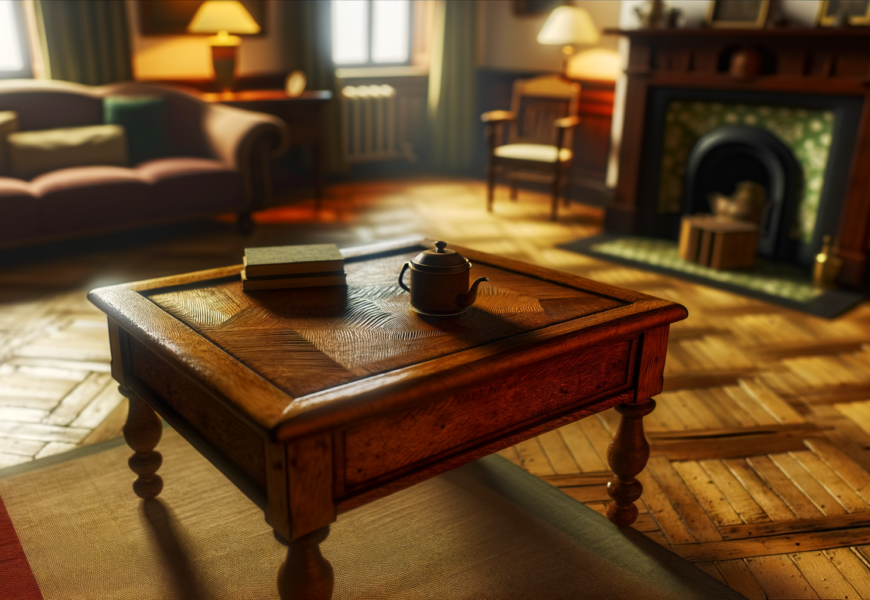The humble coffee table, a staple in living rooms worldwide, has a rich history and a dynamic evolution that is still unfolding. From its origins in aristocratic parlors to becoming a modern design icon, the coffee table reflects cultural trends and societal shifts. In this article, we'll delve into the fascinating journey of the coffee table, tracing its evolution and exploring its relevance in the contemporary home.
The Historical Origins of Coffee Tables
The origin of coffee tables can be traced back to 17th-century Europe, where they played a pivotal role in social gatherings. Initially, these tables were not specifically created for coffee but for tea settings, which were popular in aristocratic parlors. The early coffee tables were quite different from what we recognize today, often taller and more ornate.
One of the most iconic early designs was the tea table, an essential component of social rituals among the elite. These tables were designed with precision and often adorned with intricate carvings, reflecting the artistry of craftsmen from that era. An example of such elegance is the antique Chippendale table, embodying the blend of functionality and aesthetics that characterized the period.
The Evolution of Design and Functionality
Over the centuries, the design of coffee tables evolved significantly, adapting to changing tastes and technologies. Initially, these tables were simple, made from wood, but they gradually became more elaborate as the needs and preferences of society changed. By the early 20th century, with the advent of various materials and refining techniques, coffee tables began incorporating glass and metal alongside traditional wood.
In contemporary settings, the coffee table has transformed once more. Today's designs feature smart features such as wireless charging stations and integrated screens, merging technology with traditional craftsmanship. This evolution reflects the broader trend in modern furniture design towards multifunctionality and tech integration, adapting to the fast-paced lifestyle of the modern homeowner.
Cultural Influences and Coffee Table Trends Through the Decades
The influence of different cultural epochs is evident in the variety of coffee table designs throughout history. Consider the impact of mid-century modernism, which brought about clean lines and an emphasis on functionality. This era introduced minimalist coffee tables that catered to a more understated yet elegant aesthetic, breaking away from the ornate designs of the past.
Moving forward to 2024, emerging trends suggest a hybrid approach, combining vintage and modern elements. We observe a rise in eco-conscious designs that use sustainable materials and endorse minimalist principles. The use of hybrid furniture—pieces that serve multiple purposes—is also gaining traction, aligning with the needs of compact living spaces in urban settings.
Innovative Materials and Sustainable Practices in 2024
Modern consumers are increasingly drawn to sustainable furniture design, and coffee tables are no exception. In 2024, we're seeing a significant shift towards eco-friendly materials such as recycled wood, glass, and innovative composites. These materials not only reduce environmental impact but also offer durability and aesthetic appeal.
Designers are using innovative applications of materials to create statement pieces that reflect both style and social responsibility. This trend towards sustainability underscores a larger movement within interior design, where the choice of materials is as important as the design itself, reinforcing the intrinsic connection between environmental awareness and modern living.
Coffee Tables in Modern Interior Design
Today, a coffee table is more than just a functional piece; it is often the focal point of a living room, tying together the aesthetic threads of interior design. The right coffee table can define a space, adding depth and character to a room while complementing other furniture and decor.
When selecting a coffee table, it's crucial to consider the balance between aesthetics, functionality, and personalization. Think about how the table fits within the overall design theme of your living room, and ensure it meets your practical needs—from storage to surface space. The use of multifunctional space planning can be particularly advantageous in modern homes, where maximizing utility without sacrificing style is essential.
To modernize—or even personalize—the coffee table experience, consider investing in custom designs that cater to specific tastes and requirements. Whether your style leans toward the classic elegance of Scandinavian design or the bold flair of art deco coffee tables, there are options available that reflect personal style while staying on trend with current design movements.
In conclusion, the coffee table's journey from a practical addition to tea gatherings to a centerpiece of modern homes is a reflection of evolving cultural and design narratives. As we move into 2024, understanding its historical development and current trends can enhance our appreciation for this essential piece of furniture. Stay ahead of the curve by embracing new trends, sustainable practices, and innovative designs, ensuring that your coffee table is a true reflection of your style and values.
Whether you're redesigning your living space or simply admiring coffee table art, this piece remains a vital blend of form and function in homes around the world. Embrace the past, appreciate the present, and look forward to the future of coffee tables that continue to inspire and adapt.









